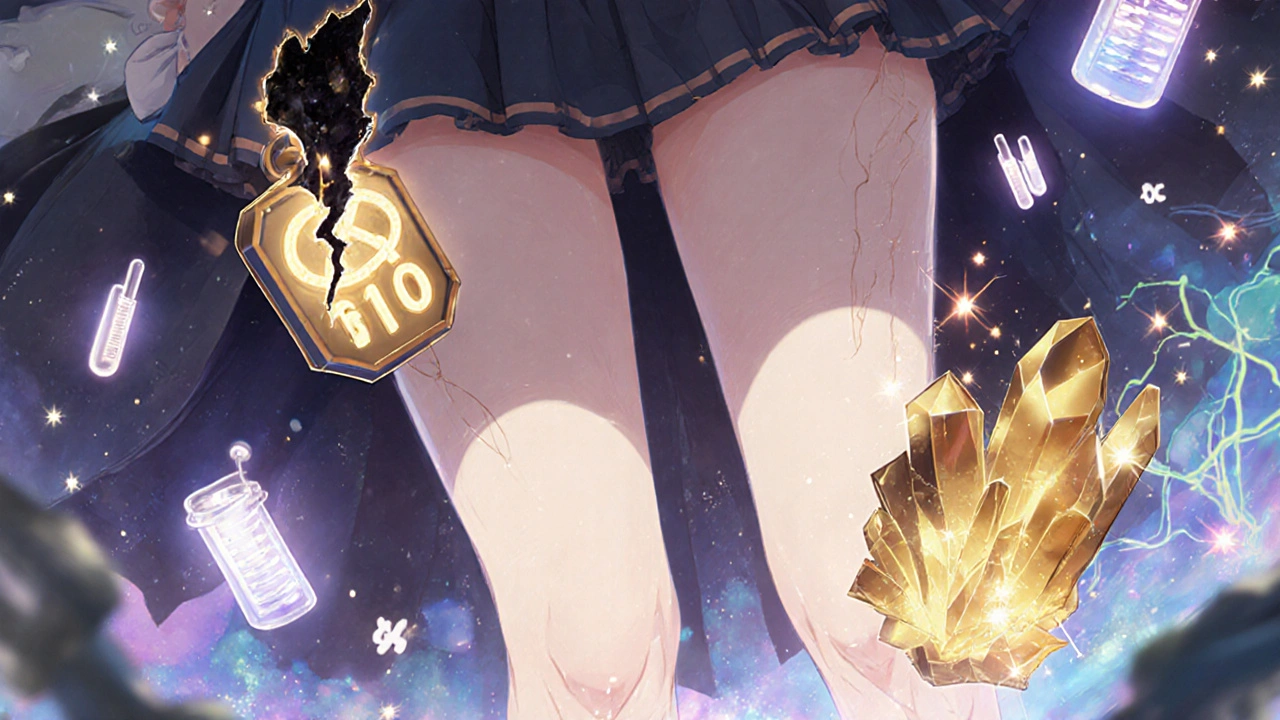Statin Symptom Checker
This tool helps determine if your symptoms are more likely statin myopathy or neuropathy based on your symptom pattern and test results.
Your Symptoms
Select all symptoms that apply to you (selecting multiple will give more accurate results)
Symptom Location
Where do your symptoms primarily occur?
CK Test Results
Do you have a recent creatine kinase (CK) blood test?
Results will appear here
Select your symptoms and test results to see if they're more likely statin myopathy or neuropathy
When you start taking a statin to lower your cholesterol, you expect fewer heart attacks-not new aches and pains. But for many people, muscle cramps, stiffness, or burning sensations show up after a few weeks or months. The problem? These symptoms could mean two very different things: statin myopathy or statin neuropathy. And confusing them can lead to the wrong treatment-or worse, stopping a life-saving drug unnecessarily.
What’s Really Going On in Your Muscles?
Statin myopathy is a muscle problem. It’s not inflammation. It’s not an injury. It’s a quiet breakdown in how your muscle cells make energy. Statins block HMG-CoA reductase, the enzyme your liver uses to make cholesterol. But that same enzyme is also needed in your muscles to make coenzyme Q10 (CoQ10), a key player in energy production. Without enough CoQ10, your muscle cells struggle. Studies show CoQ10 drops by 40% within 30 days of starting a statin. That’s enough to cause fatigue, cramps, and weakness-especially in your thighs and hips. The symptoms are subtle at first. You notice you can’t climb stairs like you used to. Your legs feel heavy after a walk. You get cramps at night, mostly in your calves or thighs. Pain isn’t sharp-it’s a dull ache, often on both sides. You might not even realize it’s new. Many people blame aging. But if you started a statin six months ago and suddenly feel this way, it’s worth looking closer. Here’s the key: in true statin myopathy, creatine kinase (CK) levels are often normal or only slightly raised. That’s why doctors miss it. You don’t need a huge CK spike to have real muscle damage. The European Atherosclerosis Society says true myopathy-where CK is more than four times the upper limit of normal-happens in just 1 in 1,000 to 1 in 10,000 people. But muscle symptoms without major CK changes? That’s far more common, affecting 7% to 29% of users in real-world settings.Neuropathy: When the Nerves Are the Problem
Now, picture this: your feet feel like they’re wrapped in cotton. You get tingling, burning, or electric shocks in your toes. The sensation climbs up like a stocking being pulled on. You can’t feel your toes when you walk barefoot. That’s not muscle-it’s nerve damage. Peripheral neuropathy. The link between statins and neuropathy is messy. Some studies say statins increase risk. Others say they might protect against it. A 2019 case-control study of over 600 people found that statin users had a 50% lower chance of developing unexplained peripheral neuropathy. That’s not a typo. It’s real data. So why do some people still get numbness or burning after starting statins? The theory? Statins lower LDL cholesterol, and LDL carries vitamin E to your nerves. Less vitamin E might mean less protection for nerve cells. Also, CoQ10 depletion might affect nerve energy too. But unlike myopathy, neuropathy doesn’t raise CK levels. Your blood tests look fine. Your muscles are strong. But your nerves? They’re misfiring. The biggest clue? Location. Myopathy hits your hips and thighs-proximal muscles. Neuropathy hits your feet and hands-distal nerves. If your cramps are in your calves and you feel pins and needles in your toes, that’s a red flag for nerve involvement. If you can’t lift your legs off the bed or stand up from a chair without using your arms, that’s more likely myopathy.How Doctors Tell the Difference
There’s no single test. But here’s what they look for:- CK levels: High? Likely myopathy. Normal? Could be neuropathy-or nothing at all.
- Symptom pattern: Weakness in thighs? Myopathy. Numbness in feet? Neuropathy.
- Response to stopping: If symptoms fade within weeks after quitting the statin, it’s probably related. If they stick around or get worse, look elsewhere.
- Nerve conduction studies: If your doctor suspects neuropathy, they’ll order this. It measures how fast signals travel down your nerves. Slowed signals mean damage. Normal signals? The problem’s probably not your nerves.

What Happens When You Stop the Statin?
If it’s myopathy, stopping the statin usually helps. Most people feel better in 2 to 3 months. Some take longer, especially if they’ve had it for over a year. But here’s the catch: if you stop the statin and your symptoms don’t improve, the problem isn’t the statin. That’s when you need a neurologist. A 2023 case in Cureus described a patient whose leg weakness and cramps looked like Guillain-Barré syndrome-until doctors realized it was statin myopathy. That’s how tricky this can be. One patient I know in Melbourne stopped his statin after six months of cramps. His legs felt better in four weeks. He restarted a different statin-rosuvastatin-and had no issues. That’s the sweet spot: switching statins. Hydrophilic statins like pravastatin and rosuvastatin are less likely to cause muscle problems. They don’t penetrate muscle tissue as easily as lipophilic ones like simvastatin or atorvastatin. In fact, studies show about 60% of people who had myopathy with one statin can tolerate another.What About CoQ10 Supplements?
You’ve probably seen ads for CoQ10 to fix statin cramps. It sounds logical. But a 2015 JAMA study of 44 people with statin-related muscle pain found no benefit from CoQ10 compared to placebo. That’s a big deal. It means the problem isn’t just low CoQ10. It’s deeper-maybe mitochondrial dysfunction, calcium leaks, or genetic factors. Speaking of genetics: the SLCO1B1 gene variant increases your risk of myopathy with simvastatin by 4.5 times at high doses. If you’ve had muscle issues before, your doctor might test for this. But it’s not routine. Most doctors still rely on symptoms and trial-and-error.
What Should You Do If You Have Cramps?
Don’t panic. Don’t quit cold turkey. Do this:- Write down when the cramps started, where they hurt, and what makes them better or worse.
- Check your CK levels with a simple blood test. Ask your GP to order it.
- If CK is high, stop the statin and see your doctor about alternatives.
- If CK is normal but you have foot numbness, get a nerve conduction study.
- If symptoms improve after stopping, try switching to rosuvastatin or pravastatin at a low dose.
- If nothing helps, talk to a specialist. You might need ezetimibe or a PCSK9 inhibitor instead.
Final Thought: Don’t Assume It’s Aging
A lot of people over 65 dismiss muscle weakness as “just getting older.” But if it started after you began a statin, it’s not normal aging. It’s a signal. And if you’ve had numbness in your feet for months, don’t brush it off as “probably nothing.” Get it checked. Statins save lives. But they can cause real problems if you don’t know what you’re dealing with. You don’t have to choose between heart health and muscle comfort. There’s a middle path. It just takes the right questions-and the right tests.Can statins cause muscle cramps without raising CK levels?
Yes. Most cases of statin-related muscle symptoms occur with normal or only slightly elevated creatine kinase (CK) levels. The European Atherosclerosis Society recognizes that muscle pain, weakness, or cramps can happen even without major CK spikes. This is called statin-associated muscle symptoms (SAMS). True myopathy with CK over four times the upper limit is rare-about 0.05% per year. But mild symptoms are common, affecting up to 29% of users in real-world settings.
How do I know if my muscle pain is from statins or something else?
Look at timing and pattern. If symptoms started within weeks of beginning the statin and improved after stopping, it’s likely related. Also, statin myopathy typically causes bilateral (both sides) weakness in the hips and thighs-not the hands or feet. If you have numbness, tingling, or burning in your toes, it could be neuropathy. Other causes like hypothyroidism, diabetes, or vitamin B12 deficiency can mimic these symptoms, so blood tests and possibly nerve studies are needed to rule them out.
Is peripheral neuropathy a proven side effect of statins?
No, it’s not confirmed. Evidence is mixed. Some studies suggest statins might increase neuropathy risk due to lower vitamin E or CoQ10 levels. But a major 2019 study found statin users had a 50% lower risk of developing unexplained peripheral neuropathy. The NIH and European guidelines classify it as a "probable" side effect, not a confirmed one. If you have neuropathy symptoms, doctors should first check for common causes like diabetes or B12 deficiency before blaming statins.
Should I stop my statin if I get muscle cramps?
Not right away. First, get a CK blood test and review your symptoms with your doctor. If CK is normal and your cramps are in your feet, it’s probably not myopathy. If CK is high or you have thigh weakness, stopping the statin may help. But don’t quit without a plan. You can often switch to a different statin-like rosuvastatin or pravastatin-or use non-statin options like ezetimibe or PCSK9 inhibitors. Stopping statins without replacement increases heart attack risk.
Can I go back on statins after stopping for muscle cramps?
Yes, in about 60% of cases. Many people who had muscle issues with one statin tolerate another. Hydrophilic statins like pravastatin and rosuvastatin are less likely to cause problems because they don’t enter muscle cells as easily. Start at a low dose and increase slowly. If symptoms return, it confirms the statin was the trigger. If not, you’ve found a safe option. Always tell your doctor before restarting.
Do CoQ10 supplements help with statin muscle cramps?
Studies show no clear benefit. A 2015 JAMA trial with 44 patients found CoQ10 supplements didn’t reduce muscle pain any more than a placebo. While statins lower CoQ10 levels, supplementing doesn’t seem to fix the underlying issue. The problem may involve mitochondrial dysfunction or genetic factors, not just low CoQ10. Don’t waste money on supplements expecting relief-focus on finding the right statin or alternative therapy instead.





Matthew Peters
Been on atorvastatin for 3 years. Started getting calf cramps at night. Thought it was just getting old. Then I read this and got my CK checked. Normal. But my feet started tingling too. Got a nerve study. Turns out it was neuropathy. Switched to pravastatin. No more burning. Statins aren't the villain, but they're not innocent either.
Matthew Karrs
Of course the pharma giants don't want you to know CoQ10 fixes everything. They make billions off statins. That JAMA study? Funded by Big Pharma. My buddy took CoQ10 and his cramps vanished. They don't want you to know you can fix this with a $10 supplement instead of a $300 drug.
Liam Strachan
Interesting breakdown. I had similar symptoms after starting simvastatin. Normal CK, tingling in toes, no real weakness. Switched to rosuvastatin at half dose and everything cleared up in 3 weeks. Never thought to link it to the statin until I read something like this. Good to know it's not just 'aging'.
Gerald Cheruiyot
Statin myopathy or neuropathy? Maybe it's not either. Maybe it's just your body saying you're not meant to be on a drug that blocks a fundamental enzyme for 20 years. We treat cholesterol like a villain. But what if it's just trying to repair something? The real question isn't which side effect you have. It's why you needed the statin in the first place.
Michael Fessler
Important to note: statin-associated muscle symptoms (SAMS) are a clinical diagnosis, not a lab-based one. CK can be normal because the damage is subclinical - mitochondrial dysfunction, altered calcium flux, maybe even epigenetic changes in muscle stem cells. Nerve conduction studies are gold standard for neuropathy, but don't rule out small fiber neuropathy - those require skin biopsies. If you're symptomatic, don't dismiss it because labs are 'normal'.
Also, vitamin D deficiency is a massive confounder. Check that before blaming statins.
Alyssa Torres
I'm a nurse and I see this all the time. Patients panic and quit statins because their legs feel 'weird'. But they never mention their prediabetes or their 20-year smoking habit. Sometimes it's not the statin - it's the lifestyle. But sometimes it IS the statin. You need to check both. Don't shame people for wanting to feel better. And don't shame them for needing the drug. Balance is everything.
Summer Joy
THIS IS WHY I DON'T TRUST DOCTORS. They say 'it's normal' but you're in pain. They say 'it's aging' but you just started the drug. They say 'CoQ10 doesn't work' but everyone online says it does. I stopped my statin and now I'm fine. They want you addicted to pills. I'm not their lab rat. 🤬
Shiv Karan Singh
Everyone here is missing the point. Statins lower cholesterol. Cholesterol is essential for brain function. You're robbing your neurons of fuel to protect your heart. That's why you get brain fog, cramps, numbness. You're trading your mind for your arteries. And the doctors? They don't care. They just want you on the pill. I'd rather die of a heart attack than live with numb feet and a dead brain.
Ravi boy
Bro i had the same thing. Cramps in calves, numb toes. Thought i was dying. Went to doc, ck normal. He said maybe neuropathy. Got nerve test. Nothing. Then i switched to pravastatin. Boom. Gone in 2 weeks. No supplements. Just different statin. Dont panic. Just swap. Simple.
daniel lopez
They're hiding the truth. Statins cause mitochondrial damage. That's why CoQ10 doesn't work - the damage is permanent. The FDA knows. The WHO knows. But they won't warn you because the pharmaceutical industry funds every study. Your doctor is just a paid shill. You think this is medicine? It's corporate control. Stop taking it. Go keto. Lift weights. You don't need statins. You need to wake up.
Nosipho Mbambo
Wait, so... if CK is normal, but you have cramps... it's still the statin? But if you have numbness in your feet... it's not the statin? But sometimes it is? And CoQ10 doesn't work... but maybe it does? And you can switch statins... but only if you're lucky? This is so confusing. I just want to know if I should stop or not. Why is everything so complicated?
Katie Magnus
I read this and I just... cried. I thought I was weak. I thought I was getting old. I thought I was failing. But it was the statin. I switched to rosuvastatin. My legs feel like mine again. I'm not a failure. I'm not broken. I just needed someone to say: 'It's not you. It's the drug.' Thank you for this.
King Over
Been on statins 8 years. Cramps started 2 years ago. Never checked CK. Just lived with it. Read this. Got blood test. CK normal. Numb toes. Did nerve study. Mild neuropathy. Switched to pravastatin. No issues. No drama. Just science. Stop overthinking. Test. Switch. Move on.
Johannah Lavin
To anyone reading this and feeling scared: you're not alone. I was terrified when my legs started hurting after starting a statin. I thought I'd never walk pain-free again. But I talked to my doctor, got tested, switched meds, and now I'm fine. It's not a life sentence. It's a detour. And you're stronger than you think. 💛
Ravinder Singh
Real talk from India: my uncle had statin cramps for 18 months. Doctors said 'it's age'. He took CoQ10, nothing. Then switched to rosuvastatin. Gone in 3 weeks. No drama. No conspiracy. Just biology. Different statin = different muscle penetration. Simple. Also, check your vitamin D and B12. In India, 90% of people are deficient. That's the real villain, not statins.